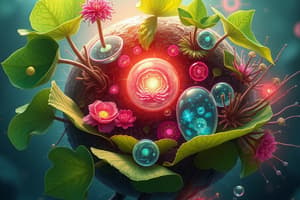Podcast
Questions and Answers
What is the by-product of the photosynthesis process?
What is the by-product of the photosynthesis process?
- Oxygen (correct)
- Carbon dioxide
- Water
- Glucose
What is the role of chlorophyll in photosynthesis?
What is the role of chlorophyll in photosynthesis?
- Converts carbon dioxide into sugar
- Converts light energy into a form usable by the plant (correct)
- Releases oxygen into the atmosphere
- Breaks down glucose into energy
What are the reactants of photosynthesis?
What are the reactants of photosynthesis?
- Chloroplasts, chlorophyll, and plant cells
- Water, carbon dioxide, and sunlight (correct)
- Glucose, water, and oxygen
- Glucose, oxygen, and chlorophyll
What does the word 'photosynthesis' mean?
What does the word 'photosynthesis' mean?
What is the primary purpose of the two-stage process of photosynthesis?
What is the primary purpose of the two-stage process of photosynthesis?
In which part of the chloroplast does the second stage of photosynthesis occur?
In which part of the chloroplast does the second stage of photosynthesis occur?
What is the role of chlorophyll in the first stage of photosynthesis?
What is the role of chlorophyll in the first stage of photosynthesis?
Which organisms, besides plants, are capable of photosynthesis?
Which organisms, besides plants, are capable of photosynthesis?
What is the primary function of glucose produced in photosynthesis for the plant?
What is the primary function of glucose produced in photosynthesis for the plant?
Flashcards are hidden until you start studying
Study Notes
Photosynthesis: Key Points and Process
- Photosynthesis occurs in two stages: the first stage involves the absorption of sunlight by chlorophyll, converting radiant energy into chemical energy, and breaking down water molecules into hydrogen and oxygen atoms; the second stage uses energy from the first to break down carbon dioxide and create glucose molecules.
- The photosynthesis equation is 6H2O + 6CO2 → C6H12O6 + 6O2, indicating the reactants and products involved in the process.
- The reaction requires six water and carbon dioxide molecules to produce one glucose molecule and six oxygen molecules.
- Photosynthesis takes place in the chloroplasts of plant cells, where chlorophyll absorbs sunlight; the process occurs in two distinct areas within the chloroplast: the thylakoids and the stroma.
- Glucose and oxygen are the products of photosynthesis, with oxygen being released into the atmosphere through small openings on the plant, and glucose serving as an energy source for the plant.
- The chloroplast, unique to plant cells, contains chlorophyll that absorbs light energy in the thylakoids during stage one of photosynthesis and facilitates the production of glucose in the stroma during stage two.
- Glucose is a form of sugar and a potential chemical energy molecule, storing energy for later use and requiring cellular respiration to release energy.
- Photosynthesis is not exclusive to plants; other autotrophic organisms such as plant-like protists and some bacteria also undergo photosynthesis, utilizing pigment molecules to absorb light energy and create their own food.
- Protists have plastids containing pigment molecules for sunlight absorption, leading to the existence of algae in various colors.
- Cyanobacteria and some bacteria use chlorophyll or bacteriochlorophyll to undergo photosynthesis, utilizing the same reactants and products as plants.
- The process of photosynthesis is essential for the production of glucose, an energy source, and oxygen, which is released into the atmosphere.
- The photosynthesis equation represents the conversion of light energy, water, and carbon dioxide into glucose and oxygen, with the process occurring in the chloroplasts of plant cells.
Studying That Suits You
Use AI to generate personalized quizzes and flashcards to suit your learning preferences.




